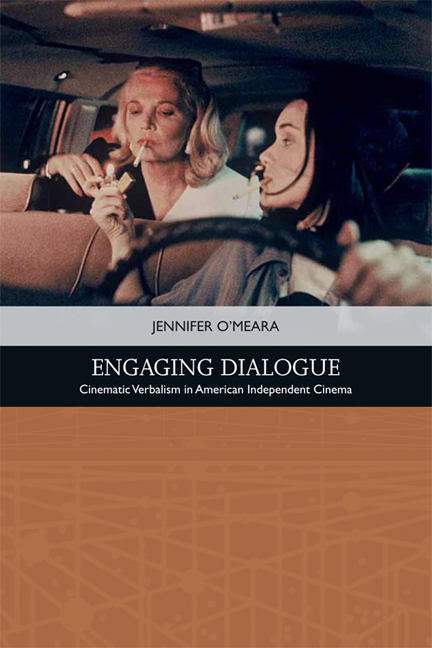Book contents
- Frontmatter
- Contents
- List of Figures
- Acknowledgements
- Introduction
- 1 Measuring Engaging Dialogue
- 2 Verbal-Visual Style and Words Visualised
- 3 The Integrated Soundtrack and Lyrical Speech
- 4 Dialogue and Character Construction
- 5 Embodying Dialogue: Rich Voices, Expressive Mouths and Gesticulation
- 6 Gendered Verbal Dynamics: Sensitive Men and Explicit Women
- 7 Adapting Dialogue and Authorial Double-voicing
- Conclusion: Verbal Extremes and Excess
- Filmography
- Bibliography
- Index
4 - Dialogue and Character Construction
Published online by Cambridge University Press: 01 May 2021
- Frontmatter
- Contents
- List of Figures
- Acknowledgements
- Introduction
- 1 Measuring Engaging Dialogue
- 2 Verbal-Visual Style and Words Visualised
- 3 The Integrated Soundtrack and Lyrical Speech
- 4 Dialogue and Character Construction
- 5 Embodying Dialogue: Rich Voices, Expressive Mouths and Gesticulation
- 6 Gendered Verbal Dynamics: Sensitive Men and Explicit Women
- 7 Adapting Dialogue and Authorial Double-voicing
- Conclusion: Verbal Extremes and Excess
- Filmography
- Bibliography
- Index
Summary
In American independent cinema, speech can be crucial both to individual character construction and to the development of group character dynamics. Dialogue is often used to individuate a character through a personalised speaking style, and nuanced choices of words and phrasing can influence how we perceive and understand characters. A character's personal development can be indicated, for example, by a communication style that evolves over the course of a film. In keeping with the tendency for indie cinema to capture the mundanity of everyday life, dialogue can also be used to create the illusion that characters exist independent of the film world – that they have lives beyond the text. The ‘liveness’ of such dialogue could be positioned as an alternative to action, but, by demonstrating the various ways in which these filmmakers foreground verbal games and debates as a form of action, this chapter reveals this to be an overly simplified relationship. Film-specific idioms and repeated words or lines of dialogue can create a complex cross-network of verbal meaning that establishes individual and groups of characters. And though this chapter focuses on the cinematic verbalists’ films, paying particular attention to Linklater's and Stillman's work in relation to verbal impressions of character autonomy and their use of idioms to represent a group of characters as a particular subculture, the analysis aims to increase our understanding of dialogue's role in characterisation more generally.
The relationship between speech and characterisation has already received a certain amount of attention. Kozloff (2000) devotes a brief section of Overhearing Film Dialogue to dialogue's function as character revelation. She notes how speech helps us distinguish one character from another and to make characters more substantial by hinting at an inner life (43). In Jaeckle's (2013b: 4) ‘primer’ on film dialogue, he uses Psycho (Hitchcock 1960) as an example to help explain how analysis of characters’ dialogue can help scholars to appreciate how verbal nuances complicate fictional personalities. In those rare instances when analyses of characterisation are grounded in dialogue, the findings can be illuminating. Hannah Patterson (2007) outlines the significance of the central characters’ different communication styles to the narrative of Badlands (Malick 1973). She notes how Holly's (Sissy Spacek) impressionability is conveyed by monosyllabic responses, contrasted with the ‘comparative abundance’ of Kit's (Martin Sheen) speech (31).
- Type
- Chapter
- Information
- Engaging DialogueCinematic Verbalism in American Independent Cinema, pp. 75 - 101Publisher: Edinburgh University PressPrint publication year: 2018



